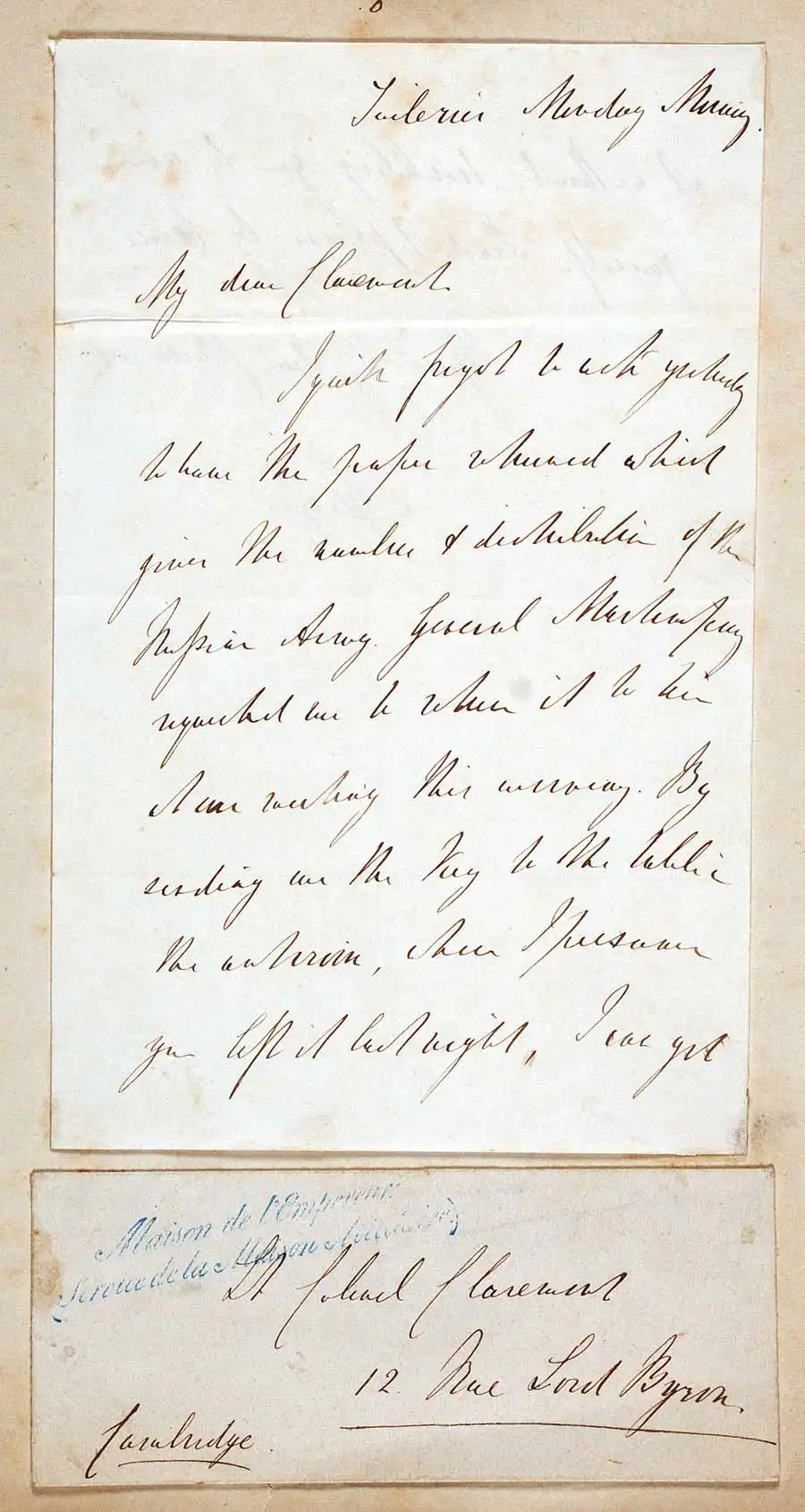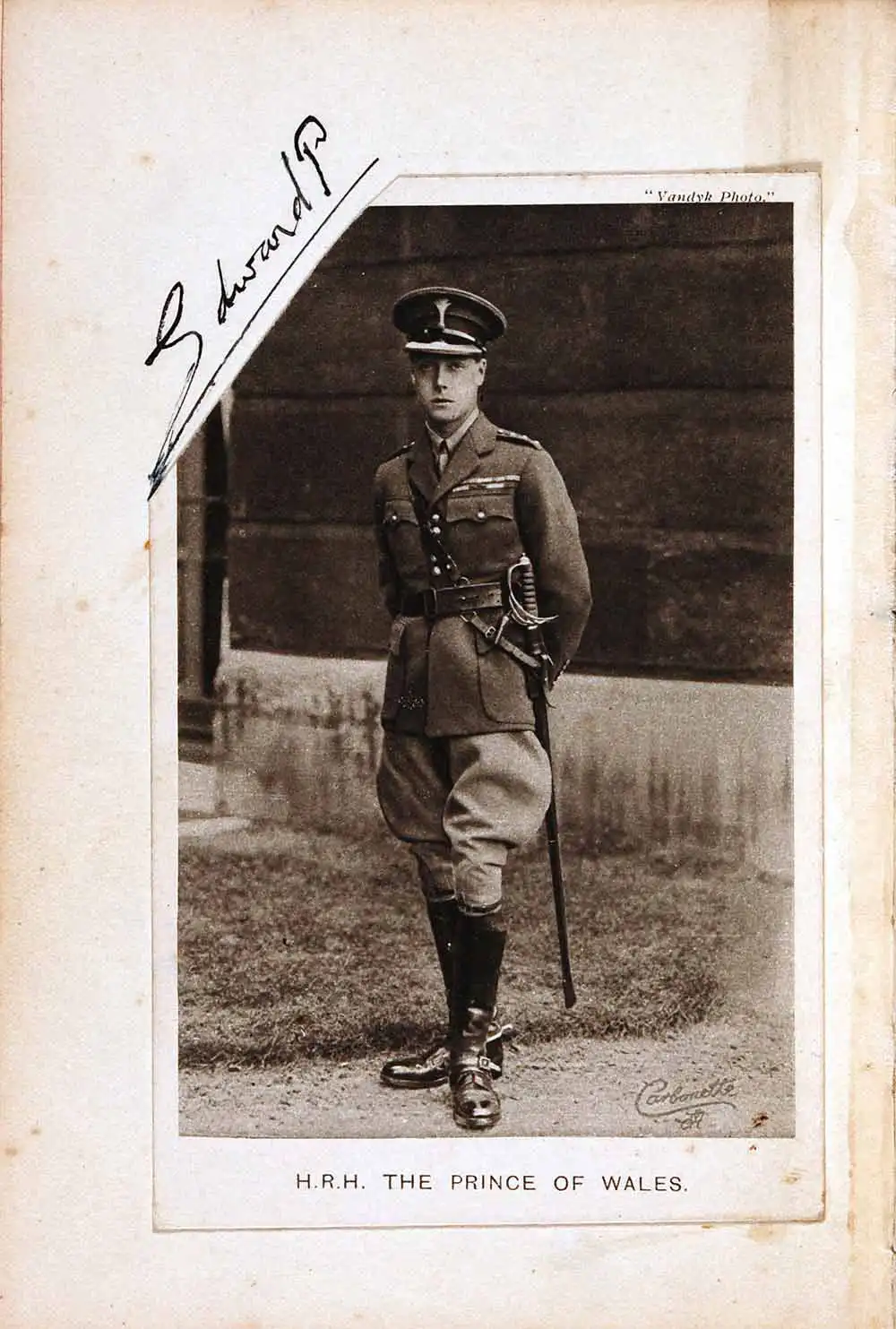Case 10
- George V & Edward VIII

Letter signed. George V (1865–1936) to ‘my dear Claremont’, Tuileries, France, ‘Monday morning’.
George V was a grandson of Queen Victoria and Prince Albert. His father, Edward VII, died in 1910, and George succeeded as King-Emperor of the British Empire on 6 May 1910. During his reign, Britain saw the rise of many political ideologies and independence movements, all of which greatly altered the political landscape, and the nation endured the horrors of the First World War. In 1917, George V changed the name of the royal household from the House of Saxe-Coburg and Gotha to the House of Windsor due to anti-German sentiment during the war.
In this letter dated informally as ‘Monday morning’, George V requested the return of a paper that gave ‘the numbers & distribution of the Russian Army’. The paper was requested by a general whose surname is as yet unidentified, and the king suggests that ‘By sending me the key to the table in the atrium where I presume you left [the paper] last night, I can get it without troubling you to come yourself. Send it please by bearer’. The location, Tuileries, presumably refers to the Hôtel des Tuileries in Paris.

Letter signed. George V (1865–1936) to ‘my dear Claremont’, Tuileries, France, ‘Monday morning’.
Open image in new window
![Printed bulletin. ‘Evening Star Extra. Approaching the end.… A bulletin at 9.30 p.m. states: – “The King’s life is moving peacefully towards its close”; annotated ‘Tuesday, 21st January 1936’. Dunedin: Evening Star Printing Office, [1936].](https://www.reedgallery.co.nz/__data/assets/image/0006/263895/case10-item2.webp)
Printed bulletin. ‘Evening Star Extra. Approaching the end.… A bulletin at 9.30 p.m. states: – “The King’s life is moving peacefully towards its close”; annotated ‘Tuesday, 21st January 1936’. Dunedin: Evening Star Printing Office, [1936].
George V developed serious health problems during the interwar years. His heavy smoking exacerbated pre-existing breathing trouble, and the king suffered from pulmonary disease and pleurisy. In 1928, George V became gravely ill with septicaemia. He never fully recovered, and needed a breathing apparatus during his final year.
Hundreds of printed bulletins such as the one exhibited here would have been posted around Dunedin, keeping the residents informed of the king’s condition at a time when not everyone owned a radio. The date in manuscript records that this unused bulletin was given to the library the day after George's death on 20 January 1936.
![Printed bulletin. ‘Evening Star Extra. Approaching the end.… A bulletin at 9.30 p.m. states: – “The King’s life is moving peacefully towards its close”; annotated ‘Tuesday, 21st January 1936’. Dunedin: Evening Star Printing Office, [1936].](https://www.reedgallery.co.nz/__data/assets/image/0006/263895/case10-item2.webp)
Printed bulletin. ‘Evening Star Extra. Approaching the end.… A bulletin at 9.30 p.m. states: – “The King’s life is moving peacefully towards its close”; annotated ‘Tuesday, 21st January 1936’. Dunedin: Evening Star Printing Office, [1936].
Open image in new window
![Special form of service in commemoration of His late Majesty King George … to be used in the Diocese of Dunedin on … Tuesday, 28th January, 1936. Dunedin: C. & W. Ltd., [1936].](https://www.reedgallery.co.nz/__data/assets/image/0007/263896/case10-item3.webp)
Special form of service in commemoration of His late Majesty King George … to be used in the Diocese of Dunedin on … Tuesday, 28th January, 1936. Dunedin: C. & W. Ltd., [1936].
Special form of service in commemoration of His late Majesty King George … to be used in the Diocese of Dunedin on … Tuesday, 28th January, 1936. Dunedin: C. & W. Ltd., [1936].
![Special form of service in commemoration of His late Majesty King George … to be used in the Diocese of Dunedin on … Tuesday, 28th January, 1936. Dunedin: C. & W. Ltd., [1936].](https://www.reedgallery.co.nz/__data/assets/image/0007/263896/case10-item3.webp)
Special form of service in commemoration of His late Majesty King George … to be used in the Diocese of Dunedin on … Tuesday, 28th January, 1936. Dunedin: C. & W. Ltd., [1936].
Open image in new window

Signature and carte de visite of Edward VIII (1894–1972) when Prince of Wales, contained in ‘Men of ANZAC, 1914–1918’ date and signature book with additional material dating to the Second World War, undated.
Before his accession to the throne, Edward was Prince of Wales and Duke of Cornwall and Rothesay. As a young man, he served in the First World War and undertook several foreign tours on behalf of his father, George V. Only months after acceding to the throne on 10 December 1936, Edward caused a constitutional crisis by proposing marriage to the American socialite Wallis Simpson. Rather than end the relationship, Edward abdicated, and was succeeded by his younger brother Albert, who became George VI (1895–1952). Never crowned, Edward’s reign of 326 days was one of the shortest in British history.
This photograph of Edward was produced some time during the First World War. His signature along the top-left corner of the page, ‘Edward P’, denotes his then status as Prince of Wales.

Signature and carte de visite of Edward VIII (1894–1972) when Prince of Wales, contained in ‘Men of ANZAC, 1914–1918’ date and signature book with additional material dating to the Second World War, undated.
Open image in new window

![Printed bulletin. ‘Evening Star Extra. Approaching the end.… A bulletin at 9.30 p.m. states: – “The King’s life is moving peacefully towards its close”; annotated ‘Tuesday, 21st January 1936’. Dunedin: Evening Star Printing Office, [1936].](https://www.reedgallery.co.nz/__data/assets/image/0006/263895/case10-item2.webp)
![Special form of service in commemoration of His late Majesty King George … to be used in the Diocese of Dunedin on … Tuesday, 28th January, 1936. Dunedin: C. & W. Ltd., [1936].](https://www.reedgallery.co.nz/__data/assets/image/0007/263896/case10-item3.webp)
